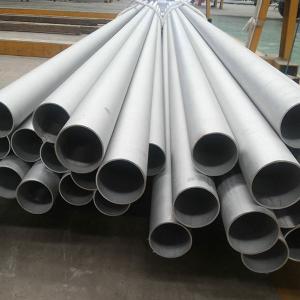
Add to Cart
ss201 ss301 ss304 ss316L ss409 ss410 ss430 Stainless steel pipe
Stainless steel pipes can be divided into CR series (400 Series), Cr Ni series (300 Series), Cr Mn Ni series (200 Series) and precipitation hardening series (600 Series). 200 series - chromium nickel manganese austenitic stainless steel 300 series - chromium nickel austenitic stainless steel.
201 stainless steel tube has the characteristics of acid resistance, alkali resistance, high density, polishing, no bubbles, no pinholes, etc. it is a high-quality material for the production of various watch cases and strap bottom covers. It is mainly used as decorative pipe, industrial pipe and some shallow stretched products.
301 good ductility, used for molding products. It can also be hardened rapidly by machining. Good weldability. The wear resistance and fatigue strength are better than 304 stainless steel.
302 ------ the corrosion resistance is the same as 304, because the carbon content is relatively high, so the strength is better.
303 ------ it is easier to cut than 304 by adding a small amount of sulfur and phosphorus.
304 - 18 / 8 stainless steel. The GB brand is 0Cr18Ni9. 309 has better temperature resistance than 304.
316 --- the second most widely used steel after 304, which is mainly used in food industry, pharmaceutical industry and surgical equipment. Molybdenum is added to obtain a special corrosion-resistant structure. Compared with 304 stainless steel pipe, it has better chloride corrosion resistance, so it is also used as "marine steel". SS316 is usually used in nuclear fuel recovery units. Grade 18 / 10 stainless steel pipes generally also meet this application grade.
Model 321 - other properties are similar to 304 except that the risk of weld corrosion of the material is reduced due to the addition of titanium.
400 series - Ferritic and martensitic stainless steel.
408 - good heat resistance, weak corrosion resistance, 11% Cr, 8% Ni.
409 - the cheapest model (British and American), usually used as automobile exhaust pipe, is ferritic stainless steel (chromium steel).
410 martensite (high strength chromium steel), good wear resistance and poor corrosion resistance.
416 - sulfur was added to improve the processability of the material.
420 - "cutting tool grade" martensitic steel, similar to the earliest stainless steel such as Brinell high chromium steel. It is also used for surgical tools, which can be made very bright.
430 ferritic stainless steel for decoration, such as automotive accessories. Good formability, but poor temperature resistance and corrosion resistance.
440 high strength cutting tool steel, with slightly higher carbon content, can obtain higher yield strength after appropriate heat treatment, and the hardness can reach 58hrc. It is one of the hardest stainless steels. The most common application example is "razor blade". There are three common models: 440A, 440b, 440C, and 440f (easy to process).
500 series - heat resistant chromium alloy steel.
600 series - Martensitic precipitation hardening stainless steel pipe.
Folded duplex stainless steel (cr18ni5mo3si2) This stainless steel has good corrosion resistance in urea carbamate solution and high stress corrosion cracking resistance in chloride environment. At the same time, the duplex stainless steel has excellent mechanical properties and can be used in plant construction with high safety requirements. Application fields: chemical industry, construction industry.
Application requirements
| Automotive industry | Stainless steel is mainly used in the exhaust system, accounting for more than 1 / 2 of the total consumption of automotive stainless steel, and 80% is ferritic stainless steel. The exhaust gas generated by the automobile engine flows out of the muffler through the exhaust gas inlet pipe, front pipe, hose, converter and central pipe. The commonly used steel grades of exhaust system are 409L, 436l, etc. Stainless steel welded pipe is mainly used for automobile muffler. It is estimated that the stainless steel pipe used in automobile accounts for about 1.5% of the consumption of stainless steel pipe in the whole downstream, while the proportion of stainless steel seamless pipe and welded pipe is about 2:1. |
| Petrochemical industry chemical fertilizer industry | There is a great demand for stainless steel pipes. Stainless steel seamless pipes are mainly used in this industry. The specifications include 304, 321, 316, 316L, 347, 317L, etc. the outer diameter is about ¢ 18 - ¢ 610 and the wall thickness is about 6mm-50mm (generally, the specification is Φ Medium and low pressure transmission pipeline above 159mm), and the specific application fields are: furnace pipe, material transmission pipe, heat exchanger pipe, etc. |
| Folding fluid transportation such as water and gas | Stainless steel pipeline and its water transmission equipment are the most advanced basic water purification materials in the world. They have strong anti-corrosion performance, which can not be compared with cast iron pipe, carbon steel pipe and plastic pipe.The best material for water industry, such as water preparation, storage, transportation, purification, regeneration and seawater desalination. |
| Equipment manufacturing and maintenance | This kind of industry mainly adopts sanitary or antibacterial stainless steel pipe. The sanitary seamless pipe made of SUS304 and 316L can meet the special requirements of various media in the field of food and biopharmaceutical. Antibacterial stainless steel has the advantages of stainless steel and good antibacterial performance. The demand for antibacterial stainless steel is increasing in the fields of kitchen equipment, workbench and utensils in food industry, medical equipment, tableware and towel hanging support in daily life, bracket of refrigerator and so on. |
